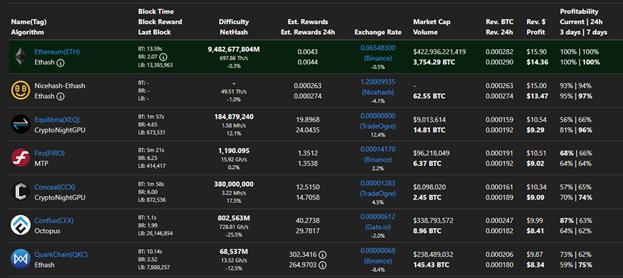As I’m sure the rest of you with GPUs that are mining Ethereum are wondering, what are things going to look like after ETHv2 gets implemented and kills ETH mining? I have been thinking a lot about this, and I wanted to throw something out there to see what anyone thinks.
Just to level set this discussion, I’m not talking about anyone with ASICs. You guys are locked into crypto mining, and that’s about it. I’m not anti-ASICs. I just haven’t had much luck with them on the scale that I’m working at (part of the garage in my house). Unless you’re buying a few hundred (or more) systems, good luck getting support when yours breaks. (Innosilicon, I’m talking to you…) It’s not worth it. Get a GPU with a warranty (or something really cheap that you can afford to break), and get mining!
Now, what do we do after Ethereum changes from Proof-of-Work (PoW) to Proof-of-Stake (PoS)? Sure, you take the ETH you have and stake it! Unfortunately, I’m still in the growth phase of my “mining empire”, so I basically have to sell any coins I make within about a month or 2 so that I can buy more cards and pay off gear. (Making up for that Innosilicon hunk-of-crap took a while. I’m still bitter…) I need to have these GPUs doing something that is valuable to someone. One of the first problems that crypto solved is facilitating transactions between 2 parties that don’t trust each other. And while that is a really hard problem to solve, GPUs can be used for all kind of other things that sound a lot more valuable. Protein folding, gene sequencing, molecular modeling, AI, ML, and the list goes on and on.
I’ve found two companies (so far) that allow you to “rent out” your systems to people that need to run these GPU applications (vast.ai and qblocks.cloud). From the surface, it looks like you can make a WHOLE LOT more with these than with mining, but the system requirements are very different than a simple rig:
- No more PCIe x1 risers, you need x16 for each GPU. Guess I can’t just hang them with zip-ties anymore.
- Number of CPU cores and amount of RAM matters again
- NVMe is likely the way to go. Be prepared to replace some if you buy cheap ones
- Be sure the review your internet terms of service for any data caps or “gotchas” for using a lot of bandwidth all month. Those ML models don’t just train themselves…
- The client is only Ubuntu Linux, and nVidia GPUs
- Docker… Get comfortable with this
Let’s talk money. How much can you make? (Not taking power into account for the comparison). The vast.ai website has a neat little section that shows how much an instance is going for (people can bid on systems). For example, a system with 2x 3090s, 64 cores, 64GB of RAM, and what looks like an 800GB NVMe drive will make about $2/Hr. That’s $48/day, or ~$1,400/Month.

If we look at whattomine.com, a 2x3090 mining rig can make $15.90/day with Ethereum. But after PoW goes away, the next best coin to mine (Not ETH) would be XEQ @ $10.54/day ($316.20/Mo). (No idea what the price will do, but miners are going to be flooding all of these other coins with horsepower).

So… $316.20/Mo vs $1,400/mo. That’s about 4x more with vast.ai then mining XEQ. Granted, getting the rig to the right specs isn’t going to be cheap, but it’s not going to take long to pay that off @ $1,400/Mo. The GPUs were the most expensive part, and I can upgrade the rest as I go (more ram this month, another NVMe drive next month, etc).
Has anyone else looked at this? After reading through this for a few days, I’m having to rethink my plan for upgrades and growth to go in this new direction. With all of the unknowns around what happens after PoW for ETH goes away, this idea seems like a great option.